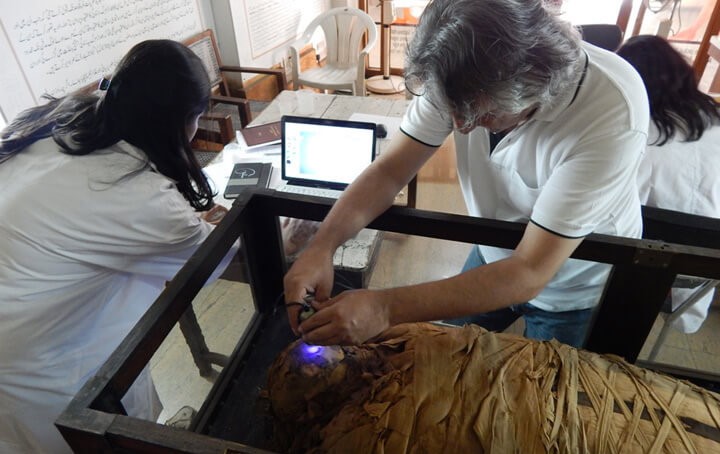The mummy has returned to the State Archaeology Museum in Hyderabad. Anupam Sah, the head conservator of Mumbai’s Chhatrapati Shivaji Maharaj Vastu Sangrahalaya, and his team have successfully restored the 4500-year-old mummified remains of Egyptian Princess Naishu.
This first of its kind restoration in India has been completed through non-invasive techniques designed by the Indian scientists themselves and is an example that can serve as a case study the world over.

Photo Source
Princess Naishu’s mummy was believed to have been purchased in Egypt by Nazeer Nawaz Jung, son-in-law of Mir Mehboob Ali Khan (the ruling Nizam of Hyderabad) for over a 1000 sterling pounds. He gifted it to the next Nizam, Mir Osman Ali Khan, who then donated it to the museum where it was kept in an airtight enclosure.
Until recently, it was believed that Princess Naishu was the 18-year-old daughter of the sixth Pharoah, who died during childbirth in 2,500 B.C. Recent medical examinations and tests conducted by the authorities have now established that Naishu was 24 when she died. Since the brain is completely removed during the mummification process, most Egyptian mummies contain no parts of the brain. Surprisingly, in this case, the mummy had significant traces of her brain intact.
Out of the six authentic Egyptian mummies in Indian museums, the mummy of Princess Naishu is the only one kept in south India.
Photo Source
Over the past year, curators discovered that the mummy, the pride of the museum since 1920, had begun to deteriorate – partly due to neglect and partly because of lack of knowledge about the best way to stem the rot. The painted hard crust that covered the cartilage of the mummy had begun falling apart, while patches over the face, the feet, the shoulders, and the torso had started to fragment and peel off. As a consequence, the bandages of the mummy were becoming loose. This could hasten the decay in the interior part of the mummy.
Requests were made for urgent expert advice from various international agencies and museums, including museums in Egypt and the British Museum in London, on how to restore the mummy. When no positive response was forthcoming, the worried authorities turned to Mr Sah, looking for answers on how to save Hyderabad state museum’s most prized relic.
You May Also Like: Now You Can Take a Virtual Tour of Kolkata’s Famous Indian Museum from the Comfort of Your Home!
When Sah joined the team, it was already too risky to move the fragile mummy. This made the restoration more complicated as the team was unable to use traditional examination techniques or treatment methods.
Also, the cloth used in binding the mummy had become brittle, so they had to rebind the cracked bandages without using any harsh chemicals or additional materials.
Photo Source
Sah and his team began the restoration process by studying samples of the linen, the surrounding debris and embalming fluids that were used for mummification thousands of years ago.
Flaking paint and cracks were repaired using conservation materials and a sterile gauze was used to hold remains of the mummy together.
Photo Story
After several weeks of careful work, the mummy was wrapped in multiple layers of cotton and carefully taken to an X-ray and CT diagnostic centre to scan the cartilage for damage. Precautions were taken to bring the mummy back to the museum before the sun became too strong.
The scans revealed that the mummy’s ribs were damaged and the spine, along with an ankle, dislocated when she was mummified. But the rest of the bones, skull and teeth were intact. The scans also revealed that there was probably a metallic amulet inside the mummy.
Photo Story
After being wrapped in a mesh-like fabric, the mummy has now been placed on an Ethafoam cushion (a temporary padding about 1.5 inches thick) in an oxygen-free case that will keep humidity, insects, and bacteria away. Care has also been taken to retain the mummy’s original look.
Mr. Sah is also the founder of the non-profit organisation, Himalayan Society for Art and Heritage Conservation, which works to protect India’s cultural heritage while reviving indigenous preservation practices and encouraging restoration. Speaking to Sriram Karri, a Hyderabad-based writer, he said:
“We maintained for a lengthy while that the present generation possessed tradition. Today, we’re slowly realising we’re merely its custodians, who have the responsibility to preserve it.”
Although it is hoped that Sah’s preservation efforts will protect the mummy from here on, a slew of measures for cosmetic protection have also been lined up.
NR Visalatchy, the director of Archaeology and Museums under the Government of Telangana, explains:
“We are now getting a nitrogen chamber for her – which will completely ensure zero-oxidation or further ageing. It is a rare piece of Egyptian history in the heart of Hyderabad. It thrills me every time I come to see her that she was living 25 centuries before Christ. We will ensure we keep her safe.”
This is the first time in India that a mummy has been really analysed, preserved, and conserved by Indian scientists. The successful restoration of Hyderabad’s Naishu mummy could set the trend for the scientific study and restoration of other mummies in the museums of India.
Also Read: Chhatrapati Shivaji Maharaj Vastu Sangrahalaya Museum in Mumbai to Install Solar Power
Like this story? Have something to share? Email: contact@thebetterindia.com, or join us on Facebook and Twitter (@thebetterindia). To get positive news on WhatsApp, just send ‘Start’ to 090 2900 3600 via WhatsApp.
We bring stories straight from the heart of India, to inspire millions and create a wave of impact. Our positive movement is growing bigger everyday, and we would love for you to join it.
Please contribute whatever you can, every little penny helps our team in bringing you more stories that support dreams and spread hope.

